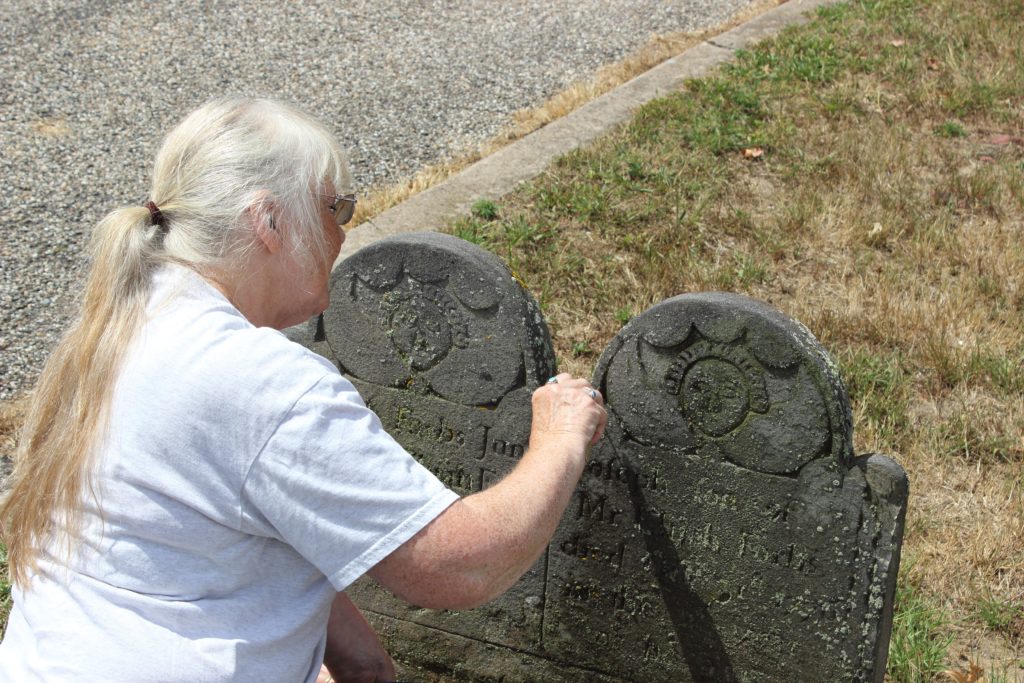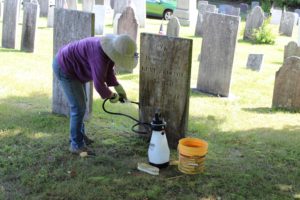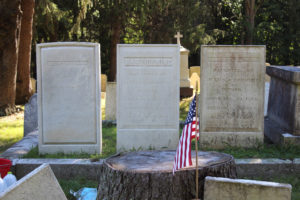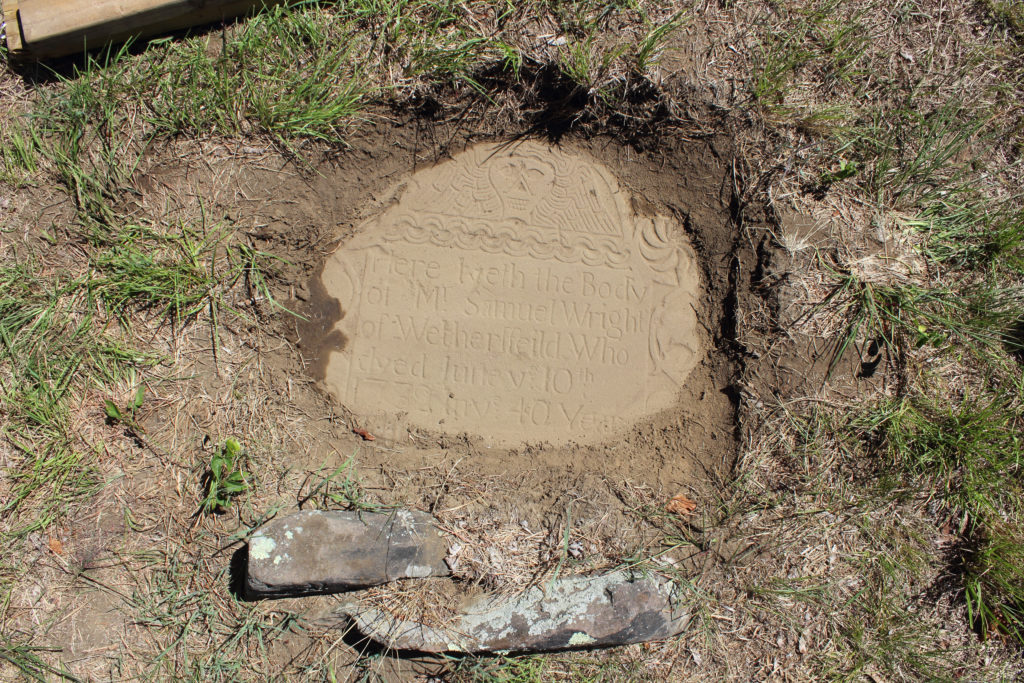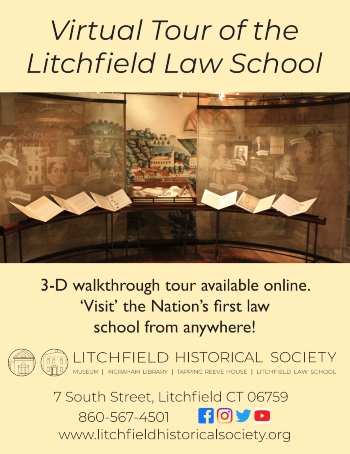By Alex Dubois
(c) Connecticut Explored Inc., Winter 2022-23
Subscribe/Buy the Issue!
Between 1916 and 1938 Charles R. Hale dedicated himself to locating and documenting Connecticut’s old burying grounds and cemeteries. Beginning as a chart of veterans’ graves in a single cemetery, Hale’s project ended as a statewide operation funded by the Works Progress Administration. Hale surveyed more than 2,200 burying grounds across Connecticut and transcribed the vital information held on surviving grave markers. Hale’s list, likely falling short of the true number of burying grounds in the state, reflects both the rich community history held in Connecticut cemeteries and the scope of the problem facing preservationists today.
According to Mary F. Striegel and her co-authors’ “Preserving Grave Markers in Historic Cemeteries,” (National Park Service (NPS) Preservation Brief 48, n.d.), gravestones are, by their nature, impermanent. All grave markers are made of natural materials that will decay over time, and too often this natural degradation is accelerated by human activity. Connecticut’s towns and cities have an abundance of old burying grounds and historic cemeteries, and, in general, too few resources to care for every stone. Preservation efforts by Connecticut citizens are becoming increasingly important.
Human intervention can prolong the life of the state’s historic grave markers, but it can also pose a serious threat. Preservation work should always be done slowly, carefully, and with proper documentation. Cleaning gravestones can improve the visibility and attractiveness of burying grounds, make gravestone inscriptions more legible, and remove materials such as biological growths that could damage stones over time. However, it is important to remember that every cleaning, even those performed with the least intrusive methods, has the potential to remove original material and damage grave markers. The NPS Preservation Brief provides a good foundation for anyone interested in learning how to responsibly clean, repair, and preserve grave markers.
Experience, Education, and Advocacy: The Connecticut Gravestone Network
Any conversation about cemetery preservation in Connecticut will likely circle back to the name of one individual: Ruth Shapleigh-Brown. Like many who choose to work or volunteer in old burying grounds, Shapleigh-Brown began her career with an indelible experience involving a gravestone. Through a family association, she visited a burial site in Maine containing the gravestone of her ancestor Dependence Shapleigh, a name she had assumed was female. The inscription on the stone, which included the rank of captain before Dependence’s name, indicated otherwise. As a guest on the June 7, 2022 episode of the “Archaeology of Connecticut” program on iCRV Radio, Shapleigh-Brown described the gravestone experience as her “lightning bolt” moment. Interacting with the stone changed how she viewed the historical importance of old burying grounds; seeing the condition of the gravesite inspired her to learn about cemetery preservation.
Shapleigh-Brown began by connecting with and learning from colleagues through the Association for Gravestone Studies, an international organization that promotes gravestone research, documentation, outreach, and preservation. She learned preservation techniques from Irving Slavid, a trained conservator who helped design the first cemetery training workshop for the NPS’s National Center for Preservation Technology and Training. She then connected with Dr. Nicholas F. Bellantoni, today the emeritus state archaeologist for Connecticut, and started working with him on cemetery projects. As more people got involved, she organized the Connecticut Gravestone Network (CGN) in 1995.
In her iCRV Radio interview, Shapleigh-Brown explained that the CGN was conceived as a place for people “to network, to work together, to share their experiences, and to support each other to help save and protect” the history told in Connecticut’s old burying grounds. The network also provides education opportunities for volunteers and the general public, including an annual symposium, hands-on workshops, cleanup days, and cemetery tours that use burial grounds around the state as teaching tools for preservation techniques and gravestone research.
After working in cemeteries for more than 30 years, Shapleigh-Brown now focuses more on organizing and connecting volunteer efforts, sharing information and resources, and advocating for change than on cleaning gravestones. She frequently works with the Connecticut State Library, the Connecticut State Historic Preservation Office, and the Connecticut Office of the State Archaeologist and advocates for an oversight committee at the state level to raise awareness of the preservation and documentation challenges facing the state’s historic burial grounds.
One of the CGN’s main goals is to facilitate safe interactions with old burying grounds among volunteers, visitors, and cemetery authorities. Shapleigh-Brown promotes low-impact cleaning procedures using only clean water and appropriate hand tools, preferring volunteers attend a workshop or cleaning day to learn how and when to use chemical cleaners. In addition to promoting the use of cemeteries for research and recreation, the network advocates against unsafe yet common cemetery activities such as gravestone rubbing that can damage markers with underlying condition issues. Shapleigh-Brown also hopes to change how cemetery authorities approach basic maintenance activities. If not used with care, mowing equipment, string trimmers, and snowplows can easily damage, displace, and even break grave markers.
Most of Shapleigh-Brown’s work has focused on Connecticut’s older, 18th-century burying grounds. In her iCRV Radio interview, she stressed that studying the state’s oldest grave markers requires an understanding of the colony’s social, economic, and geographical history. For example, early Connecticut residents had less access to local stone carvers than their neighbors in Massachusetts and Rhode Island. If early burials were marked at all, it might have been with local field stones with very minimal inscriptions. When residents began to clean up older burying grounds in the late 19th century, these field stone markers were often ignored or even removed.
Shapleigh-Brown believes that as many as two-thirds of the burials in Connecticut’s old burying grounds do not have surviving markers. If the boundaries and fences that were eventually erected at these sites only protected existing stones, they might not reflect the true boundaries of the burying ground. Shapleigh-Brown advocates that towns should carry forward any information on burying grounds found in early deeds and land records so as to inform new land purchases and alterations. New construction should provide an adequate buffer zone around known burying grounds and consider how removing trees and disturbing nearby earth may impact cemeteries through erosion and other factors. Most importantly, individuals should understand the state’s cemetery laws and contact the state archaeologist to report any discoveries.
Understanding Cemetery Laws
Piecing together the various laws and regulations that apply to old burying grounds can be difficult. According to Catherine Labadia in a 2019 article in Connecticut Explored, there is no state agency or individual responsible for the oversight of Connecticut’s thousands of cemeteries. [See “Site Lines: Grave Deeds and Abandoned Cemeteries,” Summer 2019, 50.] A number of state statutes relate to cemetery ownership, management, and care. Two statutes in particular can empower municipalities to care for threatened cemeteries within their borders. Connecticut General Statute (C.G.S.) §19a-308 allows towns to clear brush, mow lawns, repair fences and walls, and straighten stones in cemeteries and burying grounds containing more than six places of internment and not under the management of a currently functioning cemetery association. Connecticut’s abandoned cemeteries law, outlined in C.G.S. §19a-308a, allows municipalities to acquire legal title to cemeteries that meet certain conditions related to recent burial numbers and performed maintenance. Burying grounds that are listed on the state or national registers of historic places are subject to additional regulations, but they are also eligible for grant programs provided by Connecticut’s State Historic Preservation Office and other organizations.
A few statutes deal specifically with grave markers, defined in C.G.S. §19a-315 as tombs, monuments, gravestones, or fragments thereof used to mark graves in an ancient burial place, burial ground, or cemetery. C.G.S. §19a-315b protects against the removal of grave markers unless conditions are met for the purpose of reproduction, preservation, or display in an accredited museum, while C.G.S. §19a-315c provides burial ground authorities with the right to maintain a cemetery, including the repair, rehabilitation, and repositioning or resetting of grave markers. No statute, however, mandates that cemetery authorities or municipalities provide direct care to dirty, damaged, or threatened gravestones.
Cleaning with a Purpose: Litchfield Volunteers Prepare for America’s 250th
In the picturesque cemeteries of Litchfield, Connecticut, hundreds of bright, attractive, and legible gravestones stand out among the rows of 18th- and 19th-century brownstone, slate, and marble markers. A group of dedicated volunteers has spent years building relationships with local cemeteries, promoting their educational use, and cleaning, documenting, and reviving historic gravestones and monuments.
Many of the volunteers belong to the Litchfield Patriots, Inc., a nonprofit organization involved in planning the town’s 300th anniversary celebration in 2019 and one that wants to take an active role in how Litchfield marks the United States Semiquincentennial in 2026. Among them is Eileen Schmidt, who learned the fundamentals of gravestone cleaning during a workshop run by Ruth Shapleigh-Brown. The first stone she cleaned was that of Roxana Foote Beecher (1775-1816), the wife of the noted 19th-century minister Lyman Beecher, in Litchfield’s East Cemetery.
Schmidt and fellow volunteers Lee Swift, Jim Lawson, and Linda Searles have cleaned more than 650 stones in Litchfield’s East and West cemeteries, earning them an Award of Distinction from the Greater Litchfield Preservation Trust in 2020. The group makes full use of the available resources for gravestone research and documentation, including the Hale records, local and regional newspapers, archives collections, and online databases such as Find a Grave, where multiple volunteers are regular contributors. Lawson, for example, has added more than 23,000 memorials and 55,000 photographs to the database.
At the turn of the 20th century, Litchfield summer resident Charles Thomas Payne transcribed thousands of extant inscriptions found in Litchfield and Morris burying grounds. His transcriptions were printed in a volume by local publisher Dwight C. Kilbourn in 1905. In the publisher’s notice, Kilbourn stated that he had long entertained a wish of “placing in permanent form and thus preserving the rapidly disappearing inscriptions upon the tombstones of my native town.”
In 2021 Payne’s Litchfield and Morris Inscriptions helped save a disappearing gravestone. A large portion of the carved epitaph on Avis Collins Buell’s (1714-1754) ornate brownstone marker in West Cemetery was missing. Volunteers brought the stone to the attention of Mike Angelicola, a stone carver in Bristol, Connecticut. According to a July 8, 2021 article in the Waterbury Republican-American, Angelicola used Payne’s inscription book to recreate Buell’s headstone, complete with period abbreviations and an alternative spelling of her last name, Bewell, which appeared on the original headstone and surviving footstone. With the permission of the cemetery association, Angelicola placed the new headstone just in front of the original marker.
With the semiquincentennial on the horizon, Litchfield’s cemetery volunteers are working toward a new goal: to promote the town’s Revolutionary War history through cemetery studies and gravestone preservation. The group is currently completing the time-consuming task of identifying, cleaning, and marking the gravestones of all identified Revolutionary War veterans and their spouses buried in Litchfield and Morris, which remained part of Litchfield until 1859. The volunteers plan to produce brochures listing the relevant gravestones and providing short biographies of the veterans buried at each cemetery. The project joins the Patriots organization with its frequent collaborators, including the town’s historical societies, members of the local Daughters of the American Revolution and Sons of the American Revolution groups, and the American Legion posts in Bantam and Litchfield.
To give new life to neglected gravestones, the group is planning an “Adopt a Revolutionary War Patriot” program that would raise funds to replace, repair, or supplement missing and damaged markers, an area in which they have recent experience. In 2020 the Patriots oversaw the placement of a new marker at the burial site of Andrew Adams, a Litchfield resident who attended the Second Continental Congress and signed the Articles of Confederation. Funded in part by a grant from the Seherr-Thoss Foundations, the new stone sits next to Adams’s original table tomb and outlines his contributions to Litchfield and the nation.
At Home in the Dirt: Rediscovering History, Inc.
For Michael Carroll, founder and director of the nonprofit organization Rediscovering History, Inc., cemetery preservation is a way of life. Weekends see Michael and his partner Lisa Bargmann volunteering at burying grounds across the state. During the week the organization has a contract to clean and reset gravestones in Essex, where they usually work on five to six stones a day. In total Carroll travels more than 1,000 to 1,500 miles a week to clean gravestones, document his findings, and share his passion with others.
The nonprofit organization developed out of a love for history and a formative visit to a cemetery in Salem, Connecticut in 2020. Seeing the cemetery overgrown and covered with debris, and understanding that this was a widespread issue in the state, Carroll set his sights on how Connecticut citizens could help take care of historic burying grounds. Rediscovering History started with cemetery cleanups focused on clearing overgrowth and making the gravestones more visible before moving to gravestone documentation, cleaning, resetting, and repair according to the best practices outlined by the NPS and other organizations. Carroll also leads cemetery tours and workshops and advocates for gravestone studies by partnering with local historical societies, libraries, and stewardship organizations.
Rediscovering History has recently been working in Ye Antientist Burial Ground in New London, Connecticut, the oldest colonial cemetery in New London County. The hillside burial ground sits above the banks of the Thames River and offers a clear view across the water to the Fort Griswold Battlefield State Park, a site that Carroll credits with helping to begin his career in history. The organization’s work at Ye Antientist Burial Ground illustrates the importance of documentation, both in terms of conducting gravestone preservation and researching the history of each cemetery or burying ground. In addition to the Hale records for Ye Antientist, Carroll’s research file for the burial ground contains resources from history organizations in New London, including a list of inscriptions for free Black and enslaved residents buried in one section of the cemetery.
Echoing the thoughts of Shapleigh-Brown, one of his mentors, Carroll views his work as a way to connect others with the important history preserved in historic burying grounds and cemeteries. On the June 7, 2022 episode of the “Archaeology of Connecticut” on iCRV Radio, Carroll spoke about how “people are getting out, learning more about themselves, their community. The more that we clean stones, and we stand them up and get them out of the ground,” the more “we share that information with people.” Rediscovering History maintains an active Facebook presence, using the platform to share gravestone history, connect with volunteers, and promote upcoming events. Before and after photographs of each gravestone capture the work done by Carroll and the group’s volunteers and bring attention to neglected or previously undocumented gravestones.
Carroll noted in his iCRV Radio interview that locating buried or obscured stones was a “weird specialty” and that he feels at home “in the dirt.” By examining a site’s topography and the arrangement of visible stones, he has become practiced at determining where missing stones may be buried. For older burials that would use both a headstone and footstone, the presence of one marker without the other can also indicate that a stone has been buried, removed, or lost to time. Carroll uses a soil probe and test holes, always dug by hand, to locate the perimeter of a buried stone before carefully excavating the top layer of soil. After the uncovered stone is photographed and cleaned, it can be carefully removed and reset in its original location.
In his interview, Carroll remarked that resetting and cleaning gravestones allows Rediscovering History to “bring the past back to the present. You can put your hands on something, and you can feel it come alive. When you have that stone and you stand it back up, and you look at the person, and even though their body is probably gone…you tell them they still exist.”
Alexander Dubois is curator of the Litchfield Historical Society. He last wrote “Craftsmanship in Two Connecticut Landmarks,” Spring 2022.
Explore!
NPS Preservation Brief: https://www.nps.gov/tps/how-to-preserve/briefs/48-preserving-grave-markers.htm
Connecticut Gravestone Network: http://ctgravestones.org/
iCRV Radio Live Replay, “Archaeology in Connecticut”: https://www.icrvradio.com/index/playlist/?date=2022-06-11

